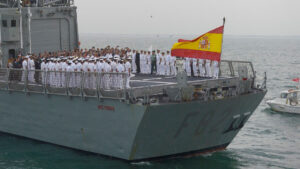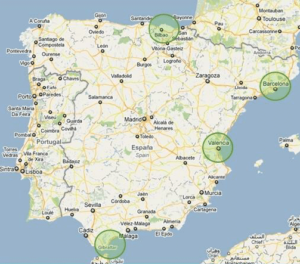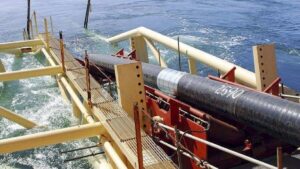Spain’s Historical Maritime Identity
Spain was known as a maritime power on account of its sea trade ,history , ports, archipelagos , numerous islands, islets and rocks which comprised almost 10,000 km of coastline. Presently Spain boasts 15 major ports. Spain is a peninsula yet also possesses islands, archipelagos and the autonomous cities of Ceuta and Melilla in the north of the African continent. The Strait of Gibraltar is strategically significant from a global shipping perspective and represents the point of maximum proximity between Europe and Africa. It seems incredible that Spain degenerated from being a maritime power to be the owner of a ramshackle collection of rusty boats that the Americans destroyed in the war of 1898.
Volume of Trade at Spanish Ports Rising
Annually 460 million tonnes of goods enter and leave Spanish ports comprising 90% of imports and 60% of total exports. Energy dependence is 70% and oil and natural gas enters Spain through its ports . Its energy security is ensured through its gas tankers, 6 regasification stations, refineries and port infrastructures. Annually around 100,000 ships sail through the Strait of Gibraltar . The volume of goods moving through Spain’s major ports rose by as much as 25% in the beginning of this year which is attributable to attacks on vessels in the Red Sea which compelled shipping lines to divert Europe-bound vessels around southern Africa instead. Spanish ports remain vital entry points to Europe for shipping lines that opt to sail around southern Africa rather than through the Red Sea .More traffic requires greater emphasis on safety and security at sea.
 Credit ; Atalayar
Credit ; Atalayar
Spanish Maritime Safety and Rescue Agency
The Spanish Maritime Safety and Rescue Agency is a Government Agency through the General Directorate of the Merchant Marine and the Ministry for Development. Basically a professional and civilian organisation it comprises of around 1.500 professionals, stationed in 20 Rescue Coordination Centres and maritime and aerial units along the Spanish coastline ensure the safety of all seafarers. The maritime agency scope of action encompasses areas of safety of life at sea and promotion of maritime safety, protection of the marine environment and control of maritime traffic through operational co-ordination and management in the event of a maritime emergency.The Search And Rescue (SAR) region covers 1,500,000 km2 being 3 times the size of the national territory divided into 4 main areas namely Atlantic, Strait of Gibraltar, Mediterranean and Canary Islands.
 Credit ; Research Gate
Credit ; Research Gate
Illegal Migrants Worrisome and Illicit Drug Smuggling
Organised crime syndicates carry out smuggling, illicit trafficking of substances and weapons, exploitation of migrants by sea and illegal fishing , plundering of cultural and historical heritage . Illegal human trafficking is particularly challenging as Spain is considered as an external border of the European Union regularly exposed to irregular migratory flows by sea.
 Credit ; Atalayar
Credit ; Atalayar
Submarine Cables
Spain’s maritime areas are criss crossed by subsea or submarine cables, gas pipelines, oil pipelines, electricity as well as digital connections with the autonomous cities and the Spanish archipelagos. Strategically important international electricity and fiber optic cables cables link Spain with America, Africa and Asia.The Spanish Maritime Safety and Rescue Agency ,which is essentially a civilian organisation , is tasked to protect Spains maritime economic areas with a flotilla including rescue vessels ,drones, towboats and helicopters. Spain has recently upgraded its maritime security doctrine and strategy in view of the Ukraine maritime crisis and Red Sea attacks.
Authored by Nadir Mumtaz
Credit/Sources ;
https://www.linkedin.com/company/salvamentomaritimo/
https://www.historyextra.com/period/spains-maritime-decline/
https://www.sciencedirect.com/science/article/abs/pii/S0957178721000291
https://www.gocomet.com/blog/major-ports-of-spain/
https://unctadstat.unctad.org/CountryProfile/MaritimeProfile/en-GB/724/index.html
http://www.salvamentomaritimo.es/statics/multimedia/documents/2024/02/05/TRIPTICO_SM_eng.pdf

Leave A Comment